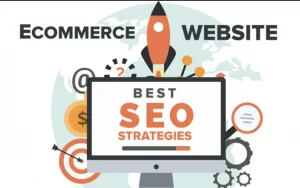Local SEO has become an essential strategy for e-commerce businesses that want to connect with nearby customers. While e-commerce often operates on a global scale, many shoppers prefer buying from businesses located in their region, whether it’s for faster delivery, trust, or a sense of community. Optimizing your e-commerce website for local SEO can help you capture this audience and stay ahead of competitors. Let’s explore actionable strategies to enhance your local SEO for better visibility and increased sales.
Why Your E-Commerce Store Needs Local SEO
Local SEO focuses on making your business visible to potential customers searching for products or services in a specific geographic area.E-commerce businesses can benefit from this by:
Visibility in local search results: Showing up in local search results when users search for products.
Improved customer trust: Shoppers often trust businesses with a local presence, especially for resolving issues quickly.
Higher sales opportunities: Combining the power of online shopping with local SEO attracts customers looking for convenience.
For example, an e-commerce business selling organic groceries can target searches like “organic vegetables near me” to attract customers in its delivery radius.
Effective Local SEO Tactics for Online Stores
1. Create and Optimize a Google Business Profile (GBP)
Create an account on Google Business (previously Google My Business). A GBP ensures your business appears in Google’s local pack, maps, and search results.
Fill out all the fields accurately, including business name, address, phone number (NAP), and website link.
Use relevant keywords in your business description, such as “fast delivery of organic groceries in New York City.”
Regularly update your profile with posts about promotions, new products, and customer reviews.
2. Include Location-Specific Keywords
Incorporate geo-targeted keywords into your website’s content, meta descriptions, and headers. For instance:
Replace generic phrases like “Buy furniture online” with “Buy handmade furniture in Chicago.”
Create location-specific landing pages for areas you serve, detailing delivery times, popular products, and customer testimonials.
3. Build Local Backlinks
Having backlinks from local websites improves the authority and ranking of your website in local search results.
Collaborate with local blogs or news outlets to feature your business.
Sponsor community events or partner with local influencers to earn mentions and links.
List your business in local directories like Yelp, Foursquare, or industry-specific directories.
4. Optimize for “Near Me” Searches
Search terms like “electronics store near me” or “same-day delivery near me” dominate local queries. To optimize for these:
Your content should naturally include phrases like “near me” or “in [city name]”.
Make sure your name, address, and phone (NAP) information is the same on all platforms.
Add schema markup to your website to provide search engines with structured data about your location and offerings.
5. Prioritize Mobile Optimization
Most local searches happen on mobile devices. Make sure the user experience on your website is seamless:
Adapt the design to various screen sizes by using a responsive layout.
Optimize loading speeds; a slow website can lead to high bounce rates.
Enable click-to-call buttons for customers to contact you instantly
6. Showcase Customer Reviews and Testimonials
Customer trust and local SEO rankings are significantly influenced by online reviews. Good reviews boost trustworthiness and draw in additional customers.
You can encourage satisfied customers to leave reviews on Google, Yelp, and other social media platforms.
Respond promptly to all reviews—thank customers for positive feedback and address concerns professionally.
Highlight glowing reviews on your website’s local landing pages.
7. Create Region-specific Content
Publishing content tailored to your local audience helps improve visibility and engagement. Ideas include:
A blog post about a local event or a trend related to your product.
Guides or tutorials showcasing how your products solve local challenges, such as “Eco-friendly pest control solutions for New Jersey homes.”
Seasonal promotions and campaigns relevant to your area.
8. Leverage Social Media for Local Engagement
Social media sites are an excellent way to get in touch with local clients. To maximize impact:
Share location-based posts or hashtags like #ShopLocalNYC or #HoustonEats.
Collaborate with local influencers to promote your products.
Use geotagging in your posts and stories to reach nearby audiences.
9. Improve Delivery Options and Highlight Them
Many local customers prioritise fast and affordable delivery. Highlight these features on your website to attract them:
Offer same-day or next-day delivery for specific regions.
Display delivery information clearly on the product and checkout pages.
Promote local delivery services in paid and organic campaigns.
10. Monitor and Refine SEO Performance
Regularly track your local SEO efforts to identify strengths and weaknesses. Use tools like:
Google Analytics: Monitor local traffic and conversions.
Google Search Console: Check rankings for location-specific keywords.
SEMrush or Moz: Analyze competitor strategies in your local area.
Continuously refine your approach based on these insights to stay ahead of competitors.
Common Mistakes to Avoid
Ignoring Mobile Users: Skipping mobile optimization can cause you to miss out on most local search traffic.
Inconsistent NAP Details: Discrepancies in your name, address, and phone number across platforms can confuse search engines and users.
Neglecting Reviews: Poor or unaddressed reviews can harm your reputation and rankings.
Conclusion
Local SEO for e-commerce is an invaluable strategy to attract and convert nearby customers. By focusing on Google Business Profile optimization, local keywords, mobile readiness, and community engagement, your e-commerce business can build trust, increase visibility, and drive sales. Remember, a well-executed local SEO strategy ensures that when customers search for products in their area, your business becomes the top choice.

